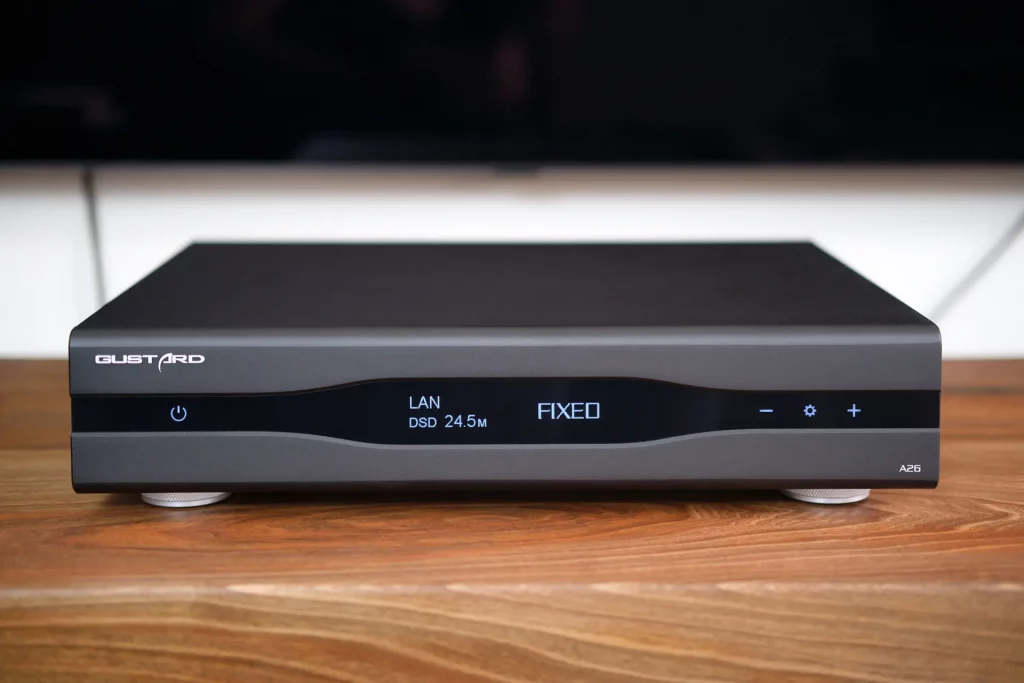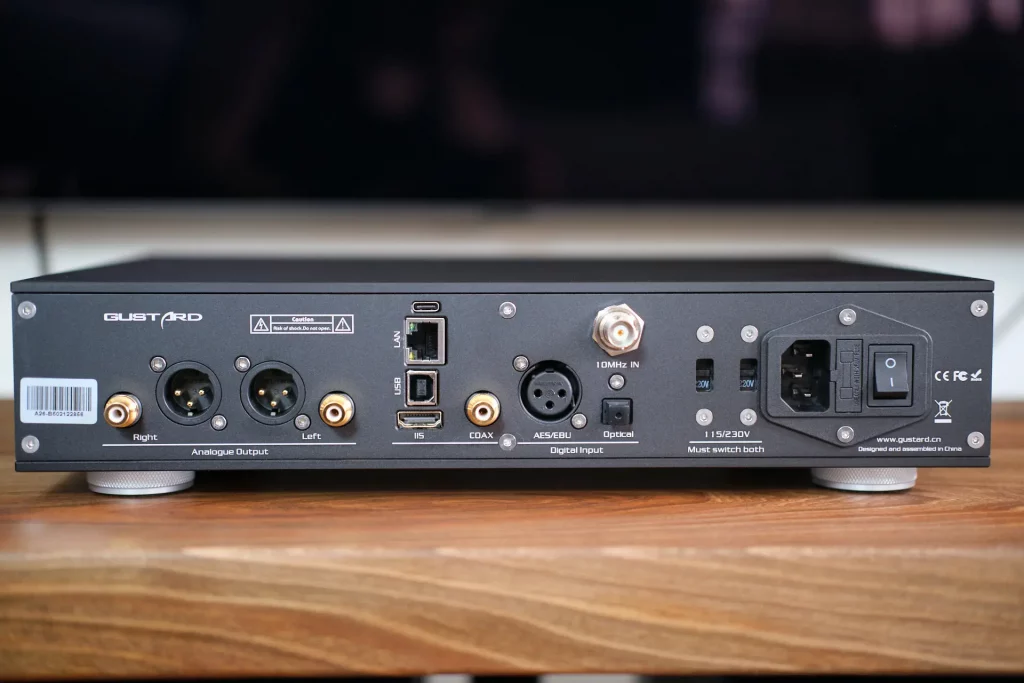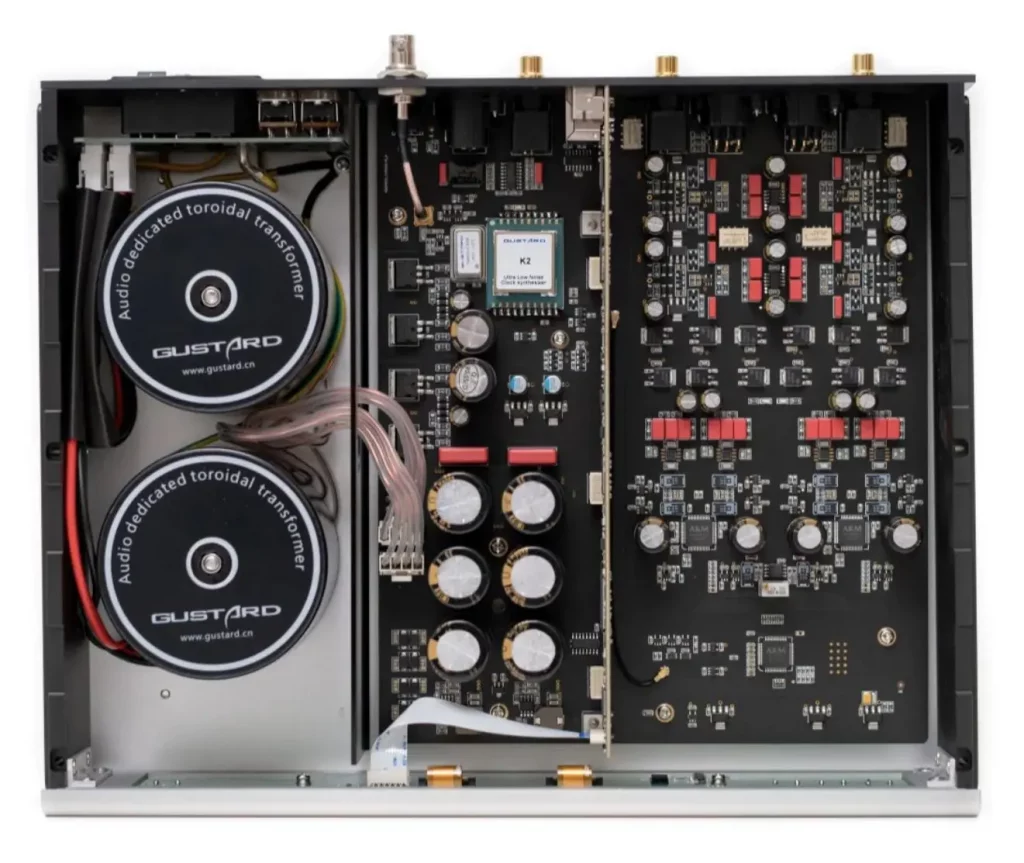A26 is the flagship DAC coming from Gustard, and it’s a mighty good one too. Up until recently, I wasn’t a big fan of Gustard DACs, but their latest R26 definitely changed that in a big way. It was the first R2R DAC entry from Gustard and it was nothing short of stunning. Gustard A26 comes as a part of the same high-level tier but uses the flagship Asahi Kasei DAC chip instead of the R2R ladder. What does this mean for the sound and which one should catch your attention? Keep reading.
Build and Connectivity
Looking at an average DAC on the market nowadays I can say that A26 is quite a chunky one, with a considerable weight too. Looks are subjective, and I’ll leave that to you, but the build quality is top-notch. Just like R26, it’s made of thick aluminium and truly built like a tank. The front panel hosts a modestly sized monochromatic display that serves its purpose well. You can easily see selected input and volume level, but you’ll have to get out of the couch to navigate the menus. The menu part is usually done during the initial device setup and when we get to know the unit and its features. Once that period is over and we settle on our favorite setting, I don’t think that most people will tinker with it anymore. So this should not be a problem in everyday use, at least it isn’t for me.
The back of the unit is where things actually get interesting. Let’s start with analog outputs because that’s a shorter list. We have both single-ended RCA outs and balanced XLR outs to choose from. Both of these can be used as fixed-level outs or with volume attenuation. When it comes to digital inputs, Gustard provided a very rich selection. Usuals like USB, Coax SPDIF, and Optical Toslink are all present. Less common AES/EBU and IIS are also onboard, but probably the most uncommon input is an Ethernet port marked LAN. The LAN port is here to enable audio streaming directly from your network over UPnP or Roon protocol, where other device such as a PC or phone is used to send the audio stream through the network and A26 acts as an audio renderer.


Internals
I will be short and to the point in this section since my whole reviewing philosophy centers around the end result and not the underlying technology that helps get there. So let’s do this quickly. Instead of using a resistor ladder network that R26 relies on to conduct D/A conversion, A26 opted for the best possible Asahi Kasei DAC AK4499EX, actually two of them. These are joined by an XMOS XU216 signal processor, a precise Clock synthesizer, two toroidal transformers to power digital and analog sections of the DAC separately, high-quality power filtering, etc. You can find a long list with bells and whistles on the manufacturer’s webpage so there’s no need for me to retype it here. You got the gist – a lot of care and attention went into making this DAC and one look inside the unit confirms that.

Sound (DAC only)
First, I tested Gustard A26 using the external Pi2Design Mercury streamer. It sounds very clean, fast, and precise – traits that only the best DACs possess. In fact, I don’t remember ever testing a DAC at this price point that could match this kind of speed, clarity, and sheer detail retrieval. The bassline is deep, but nimble and grippy at all times. There is now added warmth or midbass bloat here, just pure precision and control. Midrange continues in a similar fashion, very quick, resolving, and seemingly uncolored. Highs are well-extended, open, and very airy. The overall tonality could be characterized as neutral to slightly bright maybe.
What’s not about tonality is how fast-paced this DAC sounds at all times. No matter how quick a transient is, A26 will follow with ease. This phrase might be overused but if there was ever a DAC that starts and stops on a dime – it’s A26. Even more, tones have a good tone trail, decaying naturally in time, letting you observe spatial cues around musicians. This creates a well-arranged soundstage with tones being precisely pinpointed in it. The scope of that soundstage is great in terms of width and height. Vocals and instruments are skilfully separated and there’s plenty of empty air around them. Percived soundstage depth on the other hand is nothing to write home about, and it’s simply in line with what you would expect of a good Delta Sigma DAC.
Finally, dynamics are capable too. Gustard A26 is a lively-sounding DAC with great microdynamics and decent dynamic swings when those are needed. Put it next to even the best DAC below one thousand dollars, and A26 will simply sound livelier and more expressive all around.
Sound (Streamer/Renderer)
Next, I connected A26 directly to my network using LAN input and streamed some music using UPnP-capable players such as Bubble UPnP on my smartphone. Compared to my dedicated Pi2Design Mercury streamer, this internal solution added an additional layer of clarity. Transients sounded even faster and crisper, while microdynamics improved. That said, some fullness and warmth that I was used to with my own streamer now went away. I can’t say that either solution sounded better than the other, just different. But given that Gustard A26’s integrated solution can go head to head with an external streamer costing $800 that is backed up with a $200 linear power supply, tells a lot.
Comparisons
Gustard R26 is the most logical opponent so let’s start with it. Costing roughly the same, having the same quality build, and the same set of features, the only thing left to talk about is their sound. To put it simply, R26 sounds fuller and has a richer tone timbre. It also creates just slightly less tall but noticeably deeper soundstage that feels more spacious in general. A26 is tonally leaner sounding, it has less palpable and less three-dimensional tones, but it does sound more resolving of quick transients and time domain information in general. It’s also more extended up top which creates the sound with more air and breeze. R26 is bolder, darker, and slightly slower in comparison. Which one is better is a million-dollar question. In my mind, they’re equal in quality but different in character. Which one would you prefer depends on your own taste and the rest of your system.

Chord Qutest is a very quirky product. Gustard offers more features, and better connectivity, and feels like a better package overall. All of the feature differences aside Qutest offers a deep and spacious soundstage. It’s definitely deeper and more three-dimensional than on Gustard. Basically, that’s where the advantages for Qutest end. A26 is more resolving, has more speed, more bass slam, and simply sounds more dynamically alive. It also feels more extended with the highest frequencies. It doesn’t even need a linear power supply to get there. And if you want Qutest to be at all competitive in this dual, aftermarket power supply is a must. Without it, A26 would simply be in a different league. Even with that power supply in the game, I would still give the advantage to A26 both in terms of sonics and as a better value.
Conclusion
To put it short and simple, Gustard A26 is a mighty fine-sounding product and an even mightier value once you consider everything it brings to the table. If you looked at the great R26 and everything it brought to this price point, but didn’t like its bolder and fuller R2R tonality, and wished for something very resolving, speedy, and airy – then A26 is the answer.
| GUSTARD A26 – CHARACTERISTICS |
|
Sample Rate Supported by Digital Input Channels: |







You say you weren’t impressed by Gustard DACs until the R26 and A26, but have you heard their X26 Pro? If so, what were your impressions of it?
I haven’t. Before these two I’ve listened to X16 and X18. Good DACs but not the best ones in their categories, in my opinion.
Hi,
For electronic music and old stuff as rock, pop, which is the better, A26 or R26?
Thank you 🙏🏻
R26 is fuller and more forgiving so for any old music I would go with it.
I’m thinking to replace my current DAC
my setup is
musical fidelity m5si integrated amp
volumio Rivo (with plixir power supply)
smls vmv1se DAC
speakers wharfedale Evo 4.4 towers
the Rivo is the 4th streamer, previously I had
blusound node
ifi Zen stream
eversolo dmp A6
and lastly the Rivo thanks to your reviews
your suggestion or opinion will be really appreciated as always!
What can I say, I’m a big fan of R26 and its tonally full sound signature. However it your system in your space exhibits a bit more bass and fatness then A26 could be a better choice. But if that’s not the case, R26 has my vote.
I was thinking the same since I haven’t experience R2R, I only had the smsl vmvD1se for main and schitt modi for my desktop and gym setup.
Thank you for your honest opinion and for your passion for music.
Hi !
For your preferences which one A26 or R26 will get better synergy with Aune S17 Pro amp ?
Hi great review, what connection did you use when connecting to your streamer? They say if optical or coaxial connection used on gustard a26 then its not worth buying over let’s say smsl su 10?